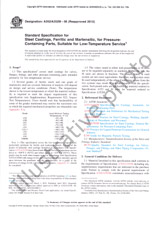We need your consent to use the individual data so that you can see information about your interests, among other things. Click "OK" to give your consent.
ASTM F3416-21
Standard Guide for Using Fourier Transform Infrared Spectrometry to Evaluate Synthetic Equine Surface Components
Translate name
STANDARD published on 15.4.2021
The information about the standard:
Designation standards: ASTM F3416-21
Publication date standards: 15.4.2021
SKU: NS-1025350
The number of pages: 3
Approximate weight : 9 g (0.02 lbs)
Country: American technical standard
Category: Technical standards ASTM
Annotation of standard text ASTM F3416-21 :
Keywords:
binder, equine surfaces, fibers, infrared spectrophotometry, wax,
Additional information
| Significance and Use |
|
5.1?FTIR can quickly be utilized to help identify polymeric fibers and some inorganic materials. FTIR also provides a means of monitoring changes to equine surface binder materials, in addition to observing oxidation. |
| 1. Scope |
|
1.1?Infrared (IR) spectrophotometry involving IR microscopes, coupled with Fourier transform infrared (FTIR) spectrometers, is a valuable method of identifying polymeric fibers (that is, polypropylene, polyethylene, etc.) and rubber used in synthetic equine surfaces. FTIR may also be used to identify organic compounds and other non-metallic elements present in the binder (that is, high-oil wax) extracted from an equine surface. FTIR of wax-based binders can also detect and quantify relative degrees of binder oxidation. FTIR works by detecting and interpreting the oscillations of the atoms bonded together in the molecular structure. Infrared light absorption spectra are generated from samples tested, and these spectra are compared to libraries of known polymer spectra. For bulk fiber samples, different fibers are visually separated into groups and individual fibers from each group are tested. For extracted wax, several tests are conducted to ensure consistency. FTIR absorption spectrums for two common fibers are shown in Fig. 1. FTIR spectrum for a wax binder exhibiting oxidation peaks is shown in Fig. 2. 1.2?The values stated in SI units are to be regarded as standard. No other units of measurement are included in this standard. FIG. 1?FTIR Identification of Polymer Types in Bulk Fiber FIG. 2?Oxidation Activity in Wax Binder over Multiple Years (Note Oxidation Peak at ~1700 cm1 (1)) 1.3?This standard does not purport to address all of the safety concerns, if any, associated with its use. It is the responsibility of the user of this standard to establish appropriate safety, health, and environmental practices and determine the applicability of regulatory limitations prior to use. 1.4?This international standard was developed in accordance with internationally recognized principles on standardization established in the Decision on Principles for the Development of International Standards, Guides and Recommendations issued by the World Trade Organization Technical Barriers to Trade (TBT) Committee. |
We recommend:
Technical standards updating
Do you want to make sure you use only the valid technical standards?
We can offer you a solution which will provide you a monthly overview concerning the updating of standards which you use.
Would you like to know more? Look at this page.




 Cookies
Cookies
